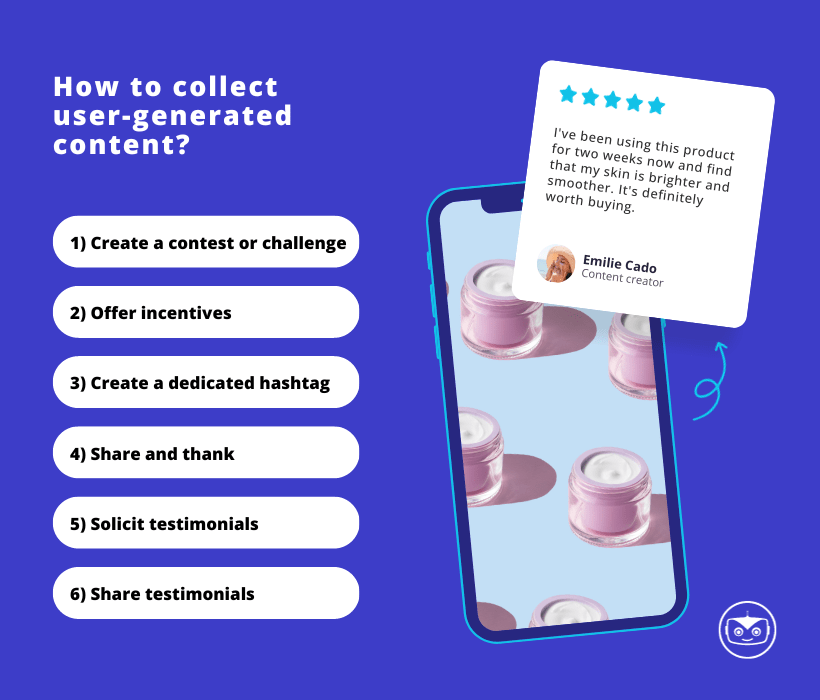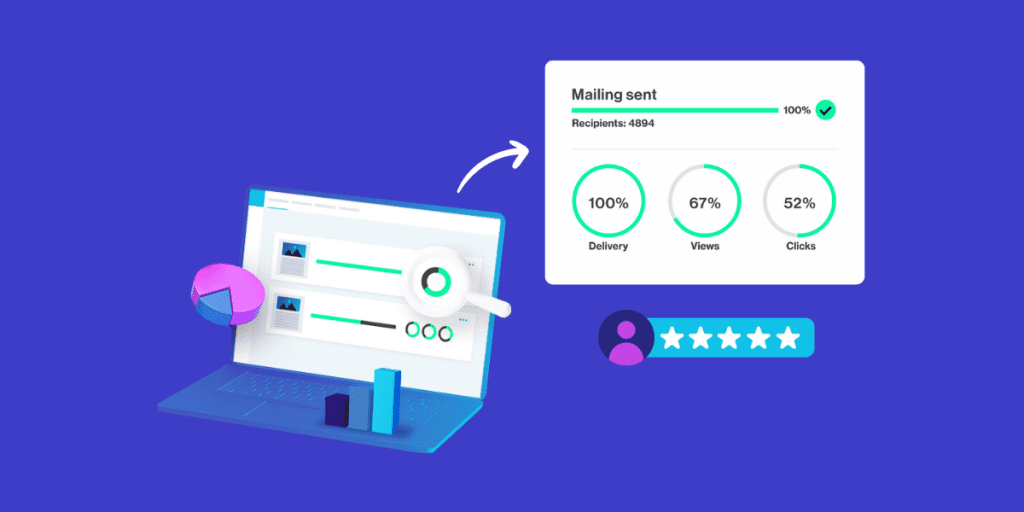Email marketing remains one of the essential cornerstones of any effective marketing strategy. However, with the ubiquity of online advertisements and consumers’ growing distrust of promotional messages, it has become imperative for marketers to find innovative and authentic ways to engage their audience. This is where ‘User-Generated Content’ (UGC) comes into play.
The benefits of user-generated content in email marketing
Integrating User-Generated Content (UGC) into your email marketing campaigns can offer a multitude of significant benefits for your business. These advantages contribute to enhancing your brand credibility, increasing subscriber engagement, and diversifying the content you share. Here are some of the key benefits to consider.
1. Credibility and trust
Testimonials and customer reviews are among the most powerful forms of User-Generated Content (UGC) for establishing your company’s credibility. They provide social proof of your customers’ satisfaction and the quality of your products or services. When these elements are included in your emails, they enhance your prospects’ trust and further encourage action.
Furthermore, emails that contain social proof, such as statistics about satisfied customers, the number of products sold, or mentions of other trusted brands or personalities, reinforce your credibility and position you as a trustworthy company.
2. Greater commitment
UGC enables more in-depth personalization of your email marketing campaigns. You can incorporate relevant testimonials or customer photos into your emails to demonstrate that you understand your customers’ individual needs, thereby strengthening their engagement.
By integrating UGC, you create dynamic interaction with your customers. You can solicit their feedback, ask them to share their stories, or participate in challenges or contests, fostering ongoing engagement with your brand.
3. Authentic and diverse content
GC comes in various forms, including product photos, videos of customers using your products, or written testimonials. This diversity of authentic content adds a personal touch to your emails and sets them apart from traditional promotional messages.
How to collect user-generated content?

Efficiently collecting user-generated content (UGC) is a crucial step in successfully integrating these elements into your email marketing campaigns. Here are some strategies to encourage your customers to contribute to UGC:
- Contests and challenges: organize contests or challenges where participants are invited to create content related to your brand. This can include videos, photos, reviews, or stories. Offer prizes or incentives to encourage participation and creativity.
- Incentives: offer incentives such as discounts, free products, or exclusive benefits in exchange for UGC. Customers will be more inclined to contribute if they perceive real value in their participation.
- Create a dedicated hashtag: establish a specific hashtag for your campaign or brand that users can use when sharing user-generated content on social media. Make sure to monitor this hashtag to easily spot your customers’ contributions.

- Share and thank: when customers share UGC, share it on your own social media accounts to thank them and show your appreciation. This further encourages more customers to contribute.
- Solicit testimonials: send specific requests to satisfied customers to gather their testimonials. You can use online forms, surveys, or personalized emails to solicit this feedback.
- Showcase testimonials: incorporate testimonials from satisfied customers into your marketing emails to demonstrate the benefits of your products or services to potential customers.


By following these strategies, you can effectively collect user-generated content and integrate it into your email marketing campaigns.
Integrate user-generated content into your email marketing campaigns
Successfully integrating user-generated content (UGC) into your email marketing campaigns requires a thoughtful and strategic approach.
1. Content selection and curation
- Quality filters: make sure to choose high-quality UGC that positively reflects your brand. Establish clear selection criteria to help identify the best contributions.
- Permission obtaining: before using UGC in your newsletters, ensure you have the creators’ permission. This can be done by explicitly requesting permission during UGC collection or by incorporating authorization clauses into your terms of use.
2. Email personalization
- Using UGC in email header and body: seamlessly integrate UGC into your emails using testimonials, photos, or videos. When customers see that others are sharing their positive experiences with your brand, it builds trust.
- Segmenting mailing list based on UGC: identify segments within your mailing list that are more likely to be interested in specific types of UGC. Customize your emails based on these segments to maximize impact.


By following these steps, you can strategically integrate UGC into your email marketing campaigns, thereby enhancing customer engagement and brand credibility.
3. Measure results and optimize
Once you have integrated user-generated content into your email marketing campaigns, it’s essential to track the results and optimize them to maximize the effectiveness of your strategy.

A) Track opening and click-through rates
Monitor your email open rates closely to determine if the inclusion of user-generated content has a positive impact on subscriber engagement.
Analyze click-through rates to understand how user-generated content influences recipient behavior. Compare them with previous campaigns to assess the effectiveness of your new approach.
B) Conversion and ROI analysis
Measure the number of recipients who took a desired action after receiving an email containing user-generated content, whether it’s a purchase, sign-up, or other relevant conversion.
Evaluate the return on investment of your campaigns by comparing the costs of collecting and using user-generated content with the revenue generated from conversions. This measurement will help you determine if your strategy is profitable.
C) Gathering user feedback
Seek feedback from your subscribers to understand their thoughts on the user-generated content in your emails. Their input can help you adjust your approach.
D) Adjustments and improvements
Use the collected data to make adjustments to your email marketing campaigns. This could involve better selection of user-generated content, finer customization, or improvements in newsletter design.
Best practices and ethical considerations
When using user-generated content (UGC) in your email marketing campaigns, it is imperative to adhere to best practices and ethical considerations. Maintaining the integrity of your marketing strategy is essential for building and sustaining customer trust, avoiding legal issues, and promoting positive relationships with your subscribers.
A. Respect for privacy and copyright
- Obtain explicit consents: before using user-generated content in your email marketing campaigns, make sure to obtain explicit consent from the creators for the use of their content. This step is crucial to avoid any copyright violations and to respect the privacy of your customers.
- Compliance with Data Protection Laws: ensure compliance with data protection regulations, such as the General Data Protection Regulation (GDPR) in Europe, the Canadian Anti-Spam Legislation (CASL) in Canada, or other similar laws in your region. Make sure your practices of collecting, storing, and using personal data align with these laws.
B. Transparency with users
- Inform your users: be transparent about how you collect, use, and share user-generated content in your emails. Provide clear information about your intentions and how users can withdraw their consent or request the deletion of their data. With Law 25, which came into effect in Quebec in September 2022, this step is even more crucial.
- Respect user preferences: honor your subscribers’ preferences regarding the frequency and type of content they want to receive. Implement easy-to-use unsubscribe mechanisms in accordance with applicable regulations.

C. Keeping it authentic
- Non-distortion of UGC: it is essential not to misleadingly alter the UGC you include in your communications. The content must remain true to the original and not be distorted or taken out of context to maintain its authenticity.
- Proper attribution: when using UGC created by others, ensure proper attribution to the creator. This can be done through direct mention or using their social media handles if appropriate.
- Avoid counterfeiting: refrain from using UGC in a way that could be perceived as a direct product or endorsement by the creator unless explicitly stated. Do not mislead users into believing that user-generated content is your own creation.
Respecting these best practices and ethical considerations is essential to ensure that the use of user-generated content (UGC) in email marketing is both effective and ethical. These principles will enable you to build a strong trust relationship with your subscribers and safeguard against potential legal issues related to UGC use. A responsible approach to UGC also helps promote a positive image of your company and enhance your brand’s reputation.
Potential challenges and how to overcome them
While using user-generated content (UGC) in your email marketing campaigns offers numerous benefits, it’s important to recognize that there can be potential challenges associated with this strategy. However, with proper planning and appropriate approaches, you can effectively overcome these challenges. Here are some potential challenges and strategies to overcome them:
| Challenges | Stratégies |
|---|---|
| 1. Obtaining sufficient UGC: it can be challenging to gather a substantial volume of UGC consistently for your campaigns. | Encourage participation: use incentives, contests, rewards, and active solicitation to encourage your customers to contribute more content. |
| 2. Managing UGC: collecting, managing, and sorting UGC can become cumbersome as the quantity increases. | Use management tools: invest in UGC management tools that streamline the process of collecting, storing, and utilizing this content. |
| 3. Variable quality: UGC can vary in terms of quality, which can affect the credibility of your campaigns. | Establish selection criteria: set clear selection criteria to ensure only high-quality UGC is used in your newsletters. |
| 4. Customers may be skeptical about the authenticity of UGC, fearing it might be altered or falsified. | Stay transparent: be transparent about how you collect and use UGC. Strictly uphold the authenticity and integrity of the content. |
| 5. Compliance with data protection laws: collecting and using UGC can raise concerns related to data protection and legal compliance. | Adhere to regulations: ensure strict adherence to data protection laws, such as GDPR in Europe, CASL in Canada, and obtain explicit consent when necessary. |
Conclusion
In summary, user-generated content represents a valuable asset for any marketer aiming to maximize the impact of their email marketing campaigns. It is a resource that embodies authenticity, credibility, and engagement, crucial elements in an increasingly saturated marketing landscape.
